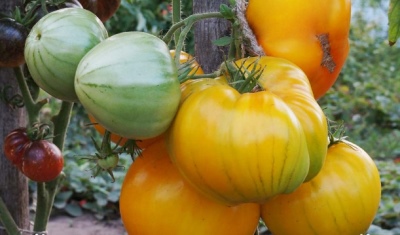
- Authors: Kudryavtseva G.A., Fotev Yu.V., Altunina L.P., Gorbunov A.B., Kotelnikova M.A., Kondakov S.N. ", IP Kondakov S.N.)
- Year of approval: 2010
- Category: grade
- Growth type: indeterminate
- Appointment: universal
- Ripening period: early
- Ripening time, days: 110-115
- Growing conditions: for open ground, for film greenhouses, for greenhouses
- Bush size: tall
- Bush height, cm: 110-190
The variety Your Majesty deserves special attention due to a large number of positive characteristics. The breeders who had a hand in the creation of this vegetable crop did not give it such a name for nothing. The special taste, stable yield, large fruit sizes and other characteristics will pleasantly surprise you.
Description of the variety
The bushes are tall and reach a height of 190 centimeters. Some plants grow up to two meters. Growth type is indeterminate. The variety is recommended to be planted either outdoors or in greenhouses. Leaves are of a standard green color, medium in size. On one brush, up to 6-8 tomatoes can ripen at the same time. During flowering, the bush is covered with a large number of bright flowers. About 30 inflorescences are formed on one plant. The stem is thick and strong.
The main qualities of the fruit
Until the tomatoes are ripe, they have a dark green spot at the stalk, the color is green. Ripe vegetables turn bright yellow. The mass reaches 200 grams, the dimensions are large. Sometimes it turns out to grow fruits up to 400 grams each. They are heart-shaped, with slight ribbing. The skin is glossy, and the flesh is fleshy and very juicy, moderately dense. In large fruits, practically no seeds are formed.
A ripe crop is stored for no more than a month and, due to its thin peel, cannot tolerate long-term transportation.
Note: if you are going to grow seedlings yourself, it is recommended to leave 2-3 vegetables, as one of them may be empty.
Taste characteristics
The taste of the fruit is marked as delicious. It is described as sweet, honeyed with fruity notes and a pleasant aroma.
Ripening and fruiting
The harvest ripens early, and the ripening period ranges from 110 to 115 days. Summer residents note long-term fruiting, which is influenced by adherence to agricultural technology.
Yield
About two kilograms of fruits are harvested from one square meter of the plantation. On average, up to 10 kilograms are obtained from each bush in one season.
The timing of planting seedlings and planting in the ground
Seeds are sown in early March. So the young seedlings will get strong enough by the time they are transplanted to a new place. Planting seedlings into the ground is carried out approximately 2 months (60-65 days) after sowing the seed. The exact dates should be calculated independently, taking into account the weather conditions in each specific region.
The soil on the site should warm up to at least +10 degrees. The seedlings will quickly adapt to such conditions in a new place and will feel comfortable. By the time of transplantation to the site, the growth of seedlings reaches about 10 centimeters. The container with plants must be hardened a week before work. For the first time, young bushes should be in the new temperature conditions for 20 minutes. After that, the time interval is gradually increased until it reaches 12 hours.
The soil on the beds is pre-prepared. It is dug up and fertilized with mineral dressings. If weeds grow on the site, they must be removed.

Growing tomato seedlings is an extremely important process, because it largely depends on whether the gardener will be able to harvest at all. All aspects must be taken into account, from seedbed preparation to planting in the ground.
Landing scheme
It is impossible to thicken the site too much. 3 bushes are grown on one square meter of territory.

Growing and care
Seedling care is carried out according to a certain scheme.
It is important to observe the correct temperature regime of 20-22 degrees Celsius. And also the plant needs daylight hours at least 14 hours a day.
Irrigate seedlings as the soil dries. The land should not be waterlogged or dry.
Complex nutrient formulations that stimulate growth are used to develop a strong root system and establish a strong stem.
In the presence of two true leaves, a pick is made.
The variety Your Majesty is unpretentious, and you can achieve an excellent harvest on any soil. And also tomatoes can easily tolerate hot weather, excess or lack of moisture. Maximum fruiting can only be achieved by creating comfortable growing conditions.
When cultivating tomatoes in greenhouse conditions, you need to regularly ventilate the room. Otherwise, excess moisture will cause plants to rot.
It is recommended to form 2-3 stems bushes. At the same time, the growth point is removed when the bush reaches a height of 1-1.2 meters. Warm water is used for irrigation. And also the shoots are tied to the supports.




A plant needs different micronutrients at each stage of growth. All fertilizers can be divided into two groups: mineral and organic. Folk remedies are often used: iodine, yeast, bird droppings, eggshells.
It is important to observe the rate and period of feeding. This also applies to folk remedies and organic fertilizers.
Disease and pest resistance
The immunity of the variety Your Majesty has an average indicator of resistance to pests and diseases. In order not to risk the health of the bushes and the quality of the crop, do not neglect preventive measures.
To protect the plantation from diseases and insects, the following conditions must be met:
plant residues and weeds are regularly removed on the site;
you need to carefully monitor the composition of the soil and its condition;
repellent plants should be planted next to the tomatoes;
in the presence of symptoms of diseases, it should be treated as soon as possible with special formulations or folk remedies.



























































































